初中英语知识点微课课件 考点精讲 同课异构 17 情态动词(14张PPT)
文档属性
| 名称 | 初中英语知识点微课课件 考点精讲 同课异构 17 情态动词(14张PPT) | 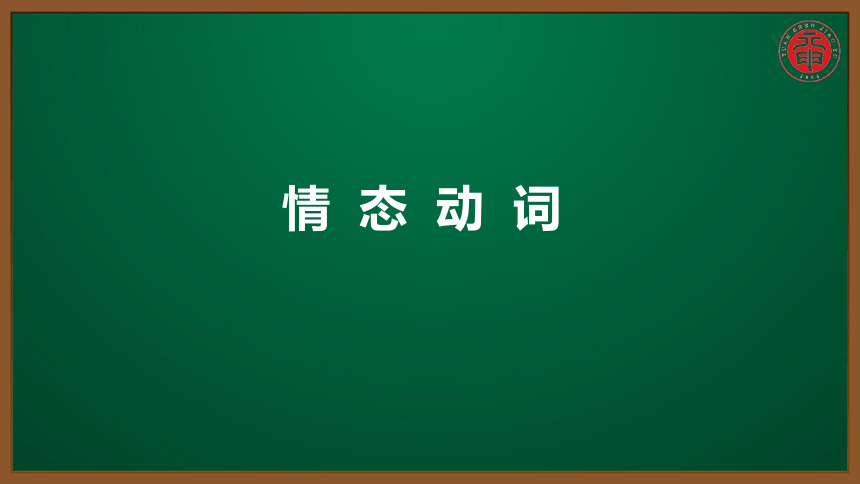 | |
| 格式 | ppt | ||
| 文件大小 | 610.5KB | ||
| 资源类型 | 试卷 | ||
| 版本资源 | 通用版 | ||
| 科目 | 英语 | ||
| 更新时间 | 2021-07-14 11:26:36 | ||
图片预览

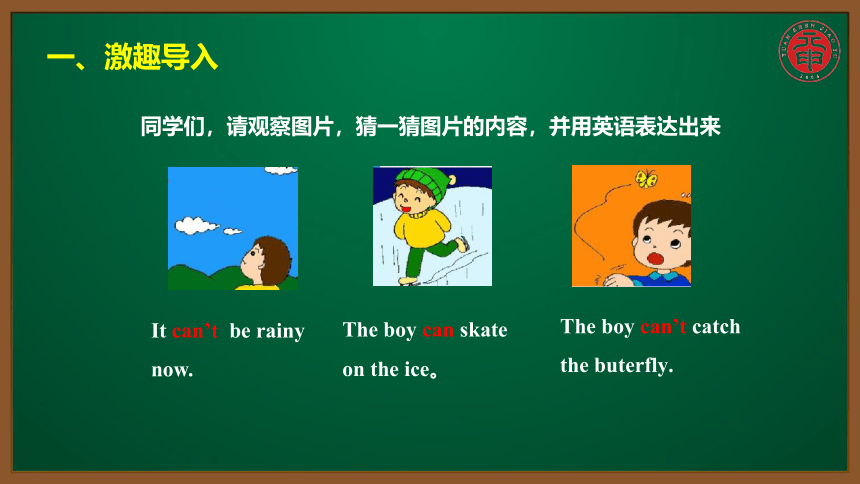
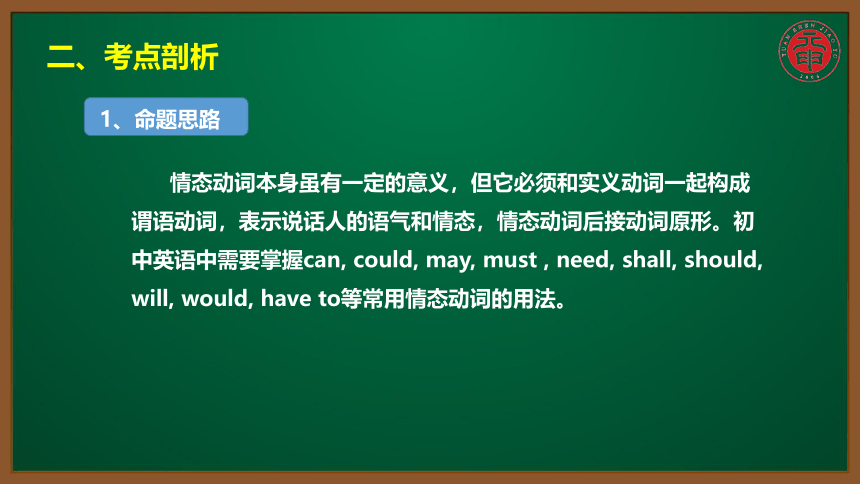
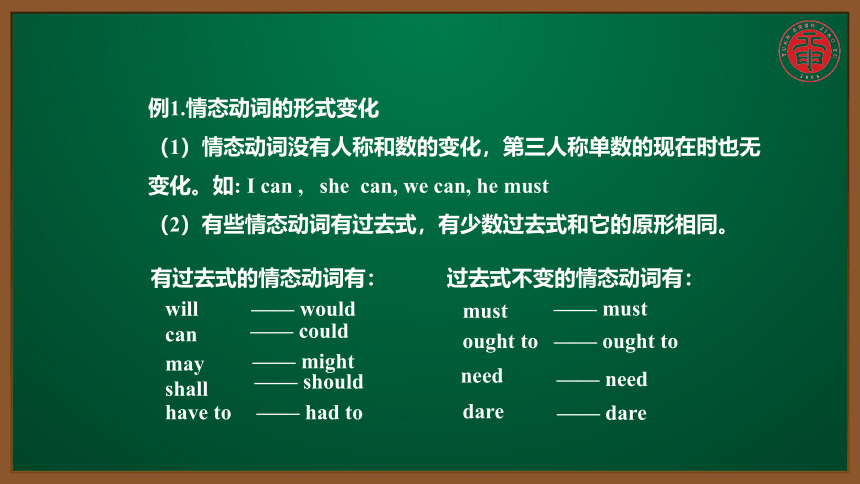
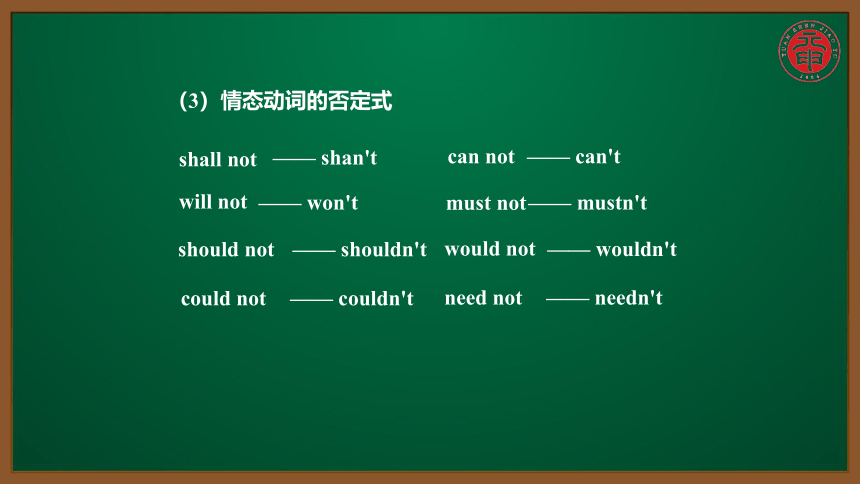
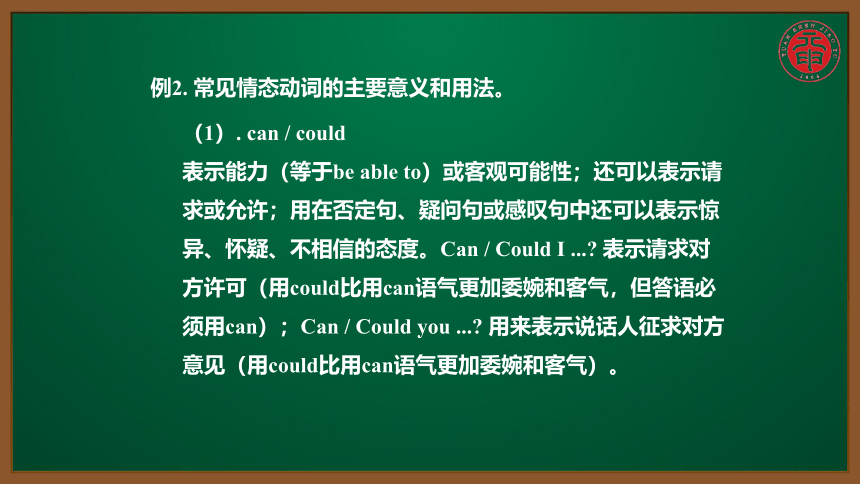
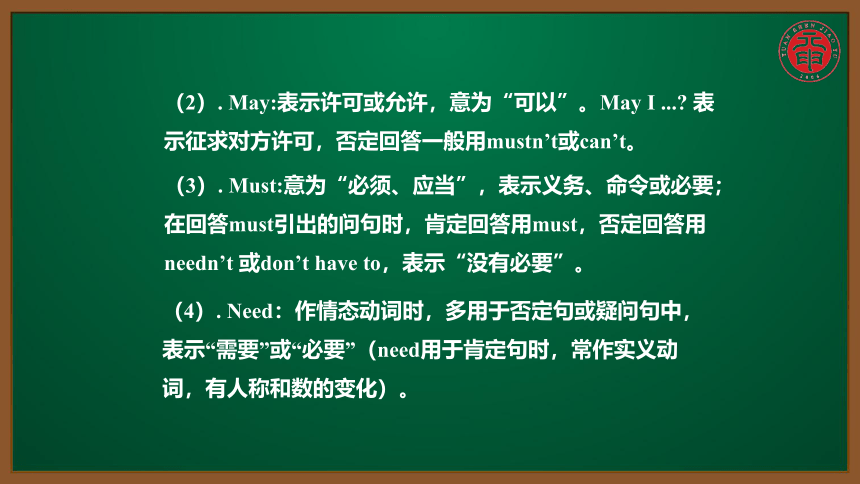
文档简介
情 态 动 词
一、激趣导入
同学们,请观察图片,猜一猜图片的内容,并用英语表达出来
It can’t be rainy now.
The boy can skate on the ice。
The boy can’t catch the buterfly.
二、考点剖析
1、命题思路
情态动词本身虽有一定的意义,但它必须和实义动词一起构成谓语动词,表示说话人的语气和情态,情态动词后接动词原形。初中英语中需要掌握can, could, may, must , need, shall, should, will, would, have to等常用情态动词的用法。
例1.情态动词的形式变化
(1)情态动词没有人称和数的变化,第三人称单数的现在时也无变化。如: I can , she can, we can, he must
(2)有些情态动词有过去式,有少数过去式和它的原形相同。
—— would
—— could
—— might
—— should
—— had to
will
can
may
shall
have to
有过去式的情态动词有:
过去式不变的情态动词有:
—— must
—— ought to
—— need
must
ought to
need
dare
—— dare
(3)情态动词的否定式
shall not
—— shan't
will not
—— won't
can not
—— can't
must not
—— mustn't
should not
—— shouldn't
would not
—— wouldn't
could not
—— couldn't
need not
—— needn't
例2. 常见情态动词的主要意义和用法。
(1). can / could
表示能力(等于be able to)或客观可能性;还可以表示请求或允许;用在否定句、疑问句或感叹句中还可以表示惊异、怀疑、不相信的态度。Can / Could I ...? 表示请求对方许可(用could比用can语气更加委婉和客气,但答语必须用can);Can / Could you ...? 用来表示说话人征求对方意见(用could比用can语气更加委婉和客气)。
(2). May:表示许可或允许,意为“可以”。May I ...? 表示征求对方许可,否定回答一般用mustn’t或can’t。
(3). Must:意为“必须、应当”,表示义务、命令或必要;在回答must引出的问句时,肯定回答用must,否定回答用needn’t 或don’t have to,表示“没有必要”。
(4). Need:作情态动词时,多用于否定句或疑问句中,表示“需要”或“必要”(need用于肯定句时,常作实义动词,有人称和数的变化)。
(5). Shall:表示说话人征求对方的意见或向对方请示。
(6). Should:意为“应该”,表示义务、责任,可用于各种句式。
(7). Will:用于疑问句中,表示说话人向对方提出请求或建议;还可以用来表示做某事的意志、意愿、决心或打算。
(9). have to:意为“不得不”,强调客观需要,能用于多种时态;而must强调说话者的主观看法,没有时态变化。
(8). would:表示过去的习惯性动作,有“总是、常常”的意思;还可表意愿、拒绝、请求 等。
?练习一:请选出正确的答案.
2、练一练
B
A
1. —Would you like to go fishing with me this afternoon?
—I’d love to, but I’m afraid I__________ . I have too much work to do.
A. can’ t B. mustn’t C. needn’t D. may not
2. —What a nice day! __________we go hiking? —Good idea.
A. Shall B. Must C. Need D. Will
3. We__________ keep the new traffic law and learn how to protect ourse lves.
A. may B. should C. can D. could
A
D
4. —Must I come at four? —Oh, no, you ___________.
A. don’t B. mustn’t C. don’t have to D. can’t
5. ___________ you get me some paper, please?
A. Shall B. May C. Need D. Will
6. —May I put my bike here?
—No, you ___________. You __________put it over there.
A. may not; may B. needn’t; must
C. mustn’t; should D. won’t; should
C
C
shouldn’t do
1. May I smoke here? (作否定回答)
__________, __________ ___________ .
2. You should do the dishes. (改为否定句)
You___________ ____________ the dishes.
3. Could I open the window? (作肯定回答)
______________ , ___________ ____________.
4. You must sell your car. (改为一般疑问句并作肯定和否定回答)
____________ ____________ sell my car?
Yes, you _____________. / No, you_____________ .
Must I
Yes you can
No you can’t
?练习二:?按要求完成下列句子,每空一词。
Must needn’t
3、答题技巧
1. 情态动词不能表示正在发生或已经发生的事情,只表示期待或估计某事的发生。
2. 情态动词 除ought 和have 外,后面只能接不带to 的不定式。
3. 情态动词没有人称,数的变化.
4. 情态动词没有非谓语形式,即没有不定式,分词等形式。
三、思维导图
一、激趣导入
同学们,请观察图片,猜一猜图片的内容,并用英语表达出来
It can’t be rainy now.
The boy can skate on the ice。
The boy can’t catch the buterfly.
二、考点剖析
1、命题思路
情态动词本身虽有一定的意义,但它必须和实义动词一起构成谓语动词,表示说话人的语气和情态,情态动词后接动词原形。初中英语中需要掌握can, could, may, must , need, shall, should, will, would, have to等常用情态动词的用法。
例1.情态动词的形式变化
(1)情态动词没有人称和数的变化,第三人称单数的现在时也无变化。如: I can , she can, we can, he must
(2)有些情态动词有过去式,有少数过去式和它的原形相同。
—— would
—— could
—— might
—— should
—— had to
will
can
may
shall
have to
有过去式的情态动词有:
过去式不变的情态动词有:
—— must
—— ought to
—— need
must
ought to
need
dare
—— dare
(3)情态动词的否定式
shall not
—— shan't
will not
—— won't
can not
—— can't
must not
—— mustn't
should not
—— shouldn't
would not
—— wouldn't
could not
—— couldn't
need not
—— needn't
例2. 常见情态动词的主要意义和用法。
(1). can / could
表示能力(等于be able to)或客观可能性;还可以表示请求或允许;用在否定句、疑问句或感叹句中还可以表示惊异、怀疑、不相信的态度。Can / Could I ...? 表示请求对方许可(用could比用can语气更加委婉和客气,但答语必须用can);Can / Could you ...? 用来表示说话人征求对方意见(用could比用can语气更加委婉和客气)。
(2). May:表示许可或允许,意为“可以”。May I ...? 表示征求对方许可,否定回答一般用mustn’t或can’t。
(3). Must:意为“必须、应当”,表示义务、命令或必要;在回答must引出的问句时,肯定回答用must,否定回答用needn’t 或don’t have to,表示“没有必要”。
(4). Need:作情态动词时,多用于否定句或疑问句中,表示“需要”或“必要”(need用于肯定句时,常作实义动词,有人称和数的变化)。
(5). Shall:表示说话人征求对方的意见或向对方请示。
(6). Should:意为“应该”,表示义务、责任,可用于各种句式。
(7). Will:用于疑问句中,表示说话人向对方提出请求或建议;还可以用来表示做某事的意志、意愿、决心或打算。
(9). have to:意为“不得不”,强调客观需要,能用于多种时态;而must强调说话者的主观看法,没有时态变化。
(8). would:表示过去的习惯性动作,有“总是、常常”的意思;还可表意愿、拒绝、请求 等。
?练习一:请选出正确的答案.
2、练一练
B
A
1. —Would you like to go fishing with me this afternoon?
—I’d love to, but I’m afraid I__________ . I have too much work to do.
A. can’ t B. mustn’t C. needn’t D. may not
2. —What a nice day! __________we go hiking? —Good idea.
A. Shall B. Must C. Need D. Will
3. We__________ keep the new traffic law and learn how to protect ourse lves.
A. may B. should C. can D. could
A
D
4. —Must I come at four? —Oh, no, you ___________.
A. don’t B. mustn’t C. don’t have to D. can’t
5. ___________ you get me some paper, please?
A. Shall B. May C. Need D. Will
6. —May I put my bike here?
—No, you ___________. You __________put it over there.
A. may not; may B. needn’t; must
C. mustn’t; should D. won’t; should
C
C
shouldn’t do
1. May I smoke here? (作否定回答)
__________, __________ ___________ .
2. You should do the dishes. (改为否定句)
You___________ ____________ the dishes.
3. Could I open the window? (作肯定回答)
______________ , ___________ ____________.
4. You must sell your car. (改为一般疑问句并作肯定和否定回答)
____________ ____________ sell my car?
Yes, you _____________. / No, you_____________ .
Must I
Yes you can
No you can’t
?练习二:?按要求完成下列句子,每空一词。
Must needn’t
3、答题技巧
1. 情态动词不能表示正在发生或已经发生的事情,只表示期待或估计某事的发生。
2. 情态动词 除ought 和have 外,后面只能接不带to 的不定式。
3. 情态动词没有人称,数的变化.
4. 情态动词没有非谓语形式,即没有不定式,分词等形式。
三、思维导图
同课章节目录
- 词法
- 名词
- 动词和动词短语
- 动词语态
- 动词时态
- 助动词和情态动词
- 非谓语动词
- 冠词
- 代词
- 数词和量词
- 形容词副词及其比较等级
- 介词和介词短语
- 连词和感叹词
- 构词法
- 相似、相近词比较
- 句法
- 陈述句
- 一般疑问句和否定疑问句
- 特殊疑问句及选择疑问句
- 反意疑问句
- 存在句(There be句型)
- 宾语从句
- 定语从句
- 状语从句
- 主谓一致问题
- 简单句
- 并列句
- 复合句
- 主谓一致
- 主、表语从句
- 名词性从句
- 直接引语和间接引语
- 虚拟语气
- 感叹句
- 强调句
- 倒装句
- 祈使句
- 句子的成分
- 句子的分类
- 题型专区
- 单项选择部分
- 易错题
- 完形填空
- 阅读理解
- 词汇练习
- 听说训练
- 句型转换
- 补全对话
- 短文改错
- 翻译
- 书面表达
- 任务型阅读
- 语法填空
- 其他资料
